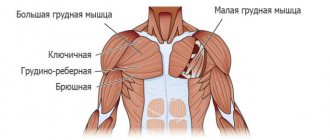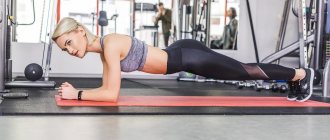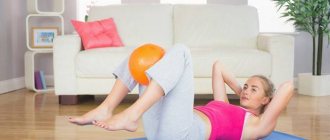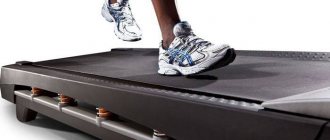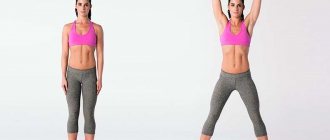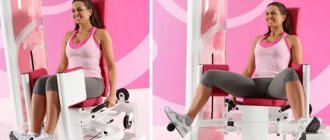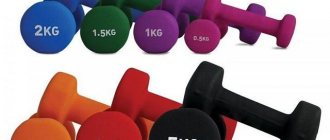Beautiful legs are the pride and undeniable dignity of every woman. Due to the modern lifestyle, the shape of the legs often leaves much to be desired: sedentary work, traveling on public transport or a private car lead to the fact that the calf muscles do not work enough during everyday activities. To have graceful, slender and toned legs, you need to exercise regularly.
Those who are involved in bodybuilding know that calves are one of the hardest muscles to “punch through”, and it is quite difficult to pump them up. This happens because, unlike the muscles of the back, abs, or biceps, these muscles are used regularly by us to varying degrees. This article contains examples of the best calf exercises for both home and gym exercises, accompanied by photos and videos, as well as tips for working on them effectively. Let's get started!
A little about anatomy
For exercise to give positive results, it is worth knowing the anatomy of the leg muscles. The lower leg includes three muscle groups - posterior, anterior and external. The muscles of the outer and anterior groups are very small and almost invisible, so you mainly need to pump up the rear muscles . The posterior group consists of two large muscles - the soleus and gastrocnemius.
- Calf – originates from the knee and ends at the Achilles tendon. It consists of two heads and covers almost the entire back surface of the lower leg. This is the most noticeable muscle, and it is the one that works the most in all exercises.
- The soleus is so named because of its shape. For the most part it is hidden by the calf, but the volume and shape of the lower leg also significantly depend on it.
These muscles are physiologically adapted to long-term physical activity, as they work during almost any of our movements. The fibers from which the calf muscles are formed are not prone to increasing volume. Therefore, in order to stimulate their growth, it is necessary to load the calves to failure, and for this it is not enough to walk or exercise with your body weight. To form a beautiful calf shape, you need to regularly exercise with weights, and then you will be able to notice a positive result.
More information on how to pump up your calves at home is described in the fitness program in the next paragraph.
Weekly calf training program at home
1. Selecting training days. For example, Monday - Thursday - Sunday. When choosing days, keep in mind
Training should be done with a break of 2-3 days, depending on the time required to recover from the previous session. A recovery period is necessary for the muscles to return to normal and the pain to go away. It is during this period that intensive muscle growth occurs. If two days after training you feel that your muscles are still sore, postpone the training for another day, since overstraining the muscles will not cause their growth, but will lead to the opposite result - their destruction.
2. Each day of class, choose three exercises you like from the ones below. 3 . Do 3-5 sets , resting a couple of minutes between sets. Each approach includes 15-30 repetitions . In general, their number depends on your endurance. If you can do more than 30 repetitions per set, this means that the selected dumbbell weight is too light.
Let us remind you that exercises for calves should be done to failure, that is, until continuation of repetitions becomes physically impossible.
Most of the exercises mentioned below are performed with dumbbells. For girls with little physical training, dumbbells weighing from 3 to 5 kg are suitable for starters, for more experienced ones - 8-10. Over time, the weight needs to be increased.
You can perform the exercises at any convenient time, in front of the TV or listening to your favorite music.
Exercises to pump up your calves at home
Raise on toes
This is the basic, most basic exercise. Stand straight, put your feet together, lower your arms with dumbbells along your body. It is advisable to find some kind of support: this is necessary for greater amplitude during movements. Place your socks on a ladder, door threshold, or thick board. Then rise on your toes as high as possible, and then slowly lower to the starting position. The calf muscle is more involved here. To thoroughly work both heads of the muscle, you can perform raises with your toes together or spread apart. If you bring the socks together, the outer part of the calf will work more, and if you spread them out, the inner calves will work more.
The correct technique is shown in the video:
This exercise can be complicated: rise not on two legs, but alternately on one. Then weights may not be needed. If after several repetitions you feel severe pain in your feet, which often happens with flat feet, try removing the stand and simply rising from the floor.
Seated knee raise
Sit on a chair or exercise ball. Place your hands with weights on your knees. Raise your feet on your toes and freeze in this position for 2-3 seconds, and then lower your heels back to the floor. This exercise focuses on the soleus muscle. You can see an example of how to pump up your calves while sitting on a fitball in the photo.
Squats on toes
Stand straight, spread your legs slightly narrower than your shoulders. Take dumbbells in your hands. Then do squats, standing on your toes. Pull your buttocks back, keeping your back straight, and then slowly rise to the starting position. Here, not only the calves are pumped, but also the muscles of the thighs and buttocks.
Advice! If doing this exercise with dumbbells is difficult, try simply stretching your arms forward.
Walking on your toes with weights
A very simple and not so boring exercise. Take dumbbells or water bottles in your hands, rise high on your toes and walk around the apartment. Try to bend your knees as little as possible. Do this until you feel a strong burning sensation in your calves.
Climbing stairs
This exercise can be done in the entrance if the neighbors do not bother you. Take dumbbells and walk up the stairs, stepping on your toes. You can step over the step: in this case, the gluteal muscles, quadriceps and hamstrings will also work. The exercise should be performed for 15-20 minutes until the muscles completely fail. One approach is sufficient here.
Jumping up
Stand up straight, take dumbbells in your hands. There will be enough small dumbbells here, you can even do without them. Squat down and jump up from this position; repeat 15-30 times. This exercise burns calories perfectly and will help not only pump up your calves, but also lose weight.
The video shows the technique of performing the exercise:
"Pistol"
This exercise is familiar to many from school physical education lessons. It can also be done with light weight. Hold a dumbbell in one hand and hold a chair or lean against a wall with the other. Extend one leg forward and squat on the other 15-30 times.
It is recommended to periodically change the exercise program, as well as regularly increase weight. Constantly performing the same exercises with the same weight becomes addictive, and the muscles stop responding to the load. As soon as you feel that you can take larger dumbbells, feel free to do so!
If you don't have dumbbells, you can pick up any suitable heavy objects, such as water bottles. Dumbbells can also be replaced with special weights that are worn on the legs.
Effective Calf Exercises to Train, Stretch and Enlarge Your Calf
I tried a huge number of calf exercises, and I realized the following:
- Like the abs, calves recover very quickly after training, so you can apply more load.
No scientific explanation has yet been found for this phenomenon, but this is confirmed by the experience of weightlifters of many generations.
- The calves respond very well to periodized exercise, which involves high intensity and high repetitions.
Periodized training involves working all muscle groups with varying variations in the number of sets, repetitions, and weight load.
These are just my theories. But they are the result of my many years of experiments and observations.
“When doing calf enlargement exercises, there are two main muscles you work: the plantaris and the gastrocnemius,” explains Cody Brown.
The gastrocnemius is the main muscle you see when looking at someone's calves - it will be thick and well defined if it is well developed. The plantaris muscle, on the contrary, is not externally visible because it is located quite deep.
“The plantaris muscle is responsible for jumping, sudden acceleration and high speed,” says William Kelly. And the soleus muscle is responsible for endurance when walking and running.
The moral of the story is: It's important to make sure you're working both muscles when training your calves. Below are the 8 best calf exercises for pumping up your lower legs at home and in the gym.
Standing calf raises with dumbbells
“This is a great exercise for strengthening and stretching the ankle muscles due to its large range of motion,” says Kelly.
- Take a dumbbell in your left hand, step onto the step with your left foot so that your heel hangs in the air, place the toe of your right foot on the ankle of your left.
- Keeping your torso tight, lift the heel of your left foot as far as possible.
- Slowly lower your heel until you feel a stretch in your calf.
- Do equal reps on each leg.
Seated calf raises
“This exercise is great for pumping up the plantaris muscle.”
- Sit on a chair or step, feet on the floor, place one heavy dumbbell on your knees.
- Keeping your torso tight, lift your heels as far as possible.
- Slowly lower your heels back to the floor and repeat this movement.
- To increase the load, Kelly suggests lifting your feet with weights.
Farmer's Walk on Toes
“This variation on the traditional Farmer's Walk is great for strengthening your calves and improving stability,” says William.
- Hold a dumbbell in each hand and stand with your feet hip-width apart.
- Release your shoulders and tighten your abs, lift your heels and stand on your toes.
- Without dropping your heels, walk either a certain number of steps or a certain amount of time.
Jumping rope
- Grab the ends of the rope with your hands, jump with both feet and rotate the rope under your feet and over your head as you jump.
We recommend: table of jumping rope for weight loss.
Dumbbell jump squats
According to Cody Brown, this plyometric exercise strengthens your calf muscles during jumping and improves stability during landing.
- Take dumbbells in your hands, place your feet shoulder-width apart.
- With your buttocks pointed back, squat until your thighs are parallel to the floor and your knee angle is 90 degrees.
- With a sharp movement, straighten your legs and jump out of the squatting position.
- Land carefully with your knees bent. After landing, we squat again. Perform several repetitions.
Downward facing dog
This classic yoga pose is a great stretch for your calf muscles.
- We start with the “table” pose: hands on the floor shoulder-width apart, feet on knees hip-width apart.
- Press your palms and toes firmly into the floor, raise your knees and slowly stretch your buttocks up.
- Without locking your knees, carefully straighten your legs so that your body takes the shape of the top of a triangle in relation to the floor.
- Remember to tighten your core muscles as you stretch your spine and lift your butt as much as possible.
- To intensify the stretch, bend one knee first and then the other.
Calf stretch against the wall with straight leg
Cody Brown says this at-home calf exercise is aimed at improving ankle flexibility.
- Stand in front of a wall at arm's length, take a step back with one leg and bend the other slightly at the knee.
- Lean forward and place your palms on the wall, trying to press the heel of your back foot into the floor to increase the tension. Make sure your leg is straight.
- Switch legs and repeat the same for the other leg.
- To highlight the plantaris muscle, you can try a variation with the knee bent on the back leg.
Standing wall stretch
Another way to stretch against a wall. This variation targets the calf muscle, but it will also help you relieve tension in the Achilles tendon. “This exercise is also great for stretching the plantar fascia, which is a common cause of heel pain,” Cody adds.
- Stand in front of a wall, place one foot forward towards the wall so that only your heel remains on the floor.
- With your hands on the wall, gently straighten your front leg and bend over until you feel a stretch in your calves.
- Switch legs and repeat.
Exercises for the gym
If you work out in the gym, do not forget to pay full attention to the muscles of the lower leg. The contrast between toned buttocks and thin calves does not look very harmonious. The above set of exercises is suitable for the gym, but you can add other exercises to it - on special simulators. Beginners should exercise on simulators only under the supervision of a trainer in order to avoid mistakes and avoid injuries.
Smith machine calf raises
A great alternative to dumbbell curls. Stand under the barbell so that it is directly above your shoulder blades. Place your toes on the platform. Perform lifts slowly and with maximum amplitude. The Smith machine allows you to use more weight than with dumbbells, and the load will be more isolated. If the bar rubs or puts a lot of pressure on your shoulders, you can wrap it with a towel or a special foam pad.
Tips for Best Muscle Growth
To speed up the growth of the lower leg muscles, you need to listen to the following recommendations:
- Be sure to warm up before classes . It is necessary to warm up the muscles and prepare them for stress. A short jog, treadmill, stepper or elliptical, or jumping rope are suitable as a warm-up. The duration of the warm-up is 5-7 minutes.
- After exercise, you need to do stretching - it gives the muscle fibers a stimulus for accelerated growth. For example, this can be done like this: lean your hands on the wall, stretch one leg back and press your heel to the floor until you feel a strong stretch in your calves; repeat with the other leg. Another way is to sit on the floor, stretch your legs forward, grab your toes with your hands and pull them towards you. The duration of the stretch is about five minutes.
- All exercises should be performed slowly. This allows you to fully experience the movements and feel maximum tension in the muscles.
- When performing movements to better stretch the calf muscles, you should do the maximum amplitude, that is, rise on your toes as high as possible and lower as low as possible.
- It is advisable to pause at the top point - at the moment of greatest muscle tension.
- You shouldn't practice too often. By doing exercises every day, you will not give your muscles rest, and then they will not recover, which means they will not grow.
- Don't forget about proper nutrition. Muscles need protein, so your diet should include foods such as chicken breast, cottage cheese, eggs, lean fish and others. It is advisable to avoid eating fatty, sweet and fried foods.
A set of exercises for calves from Iron Arnie
First, let's say a few words about warming up. “Warming up” is necessary for productive muscle work and reducing the risk of accidental injury. Therefore, before starting the lesson, perform simple elements: squats without weight, rotations in the hip, knee, ankle joints, bending forward on straight legs.
Most of the calf exercises below can be done at the gym, but there is one that you can do at home.
Seated calf raises
- We sit down in a special exercise machine for calves.
- We place our socks on the edge of the platform.
- We lower our heels down, but keep them suspended.
- We rest our knees on the cushion.
- As you exhale, strain your calves and raise your shins onto your toes.
- We maintain a 2-second pause, then, inhaling, smoothly lower the heels to the starting position.
5 sets of 6-8 reps. Rest between sets – 50-60 seconds. We use this time for a light massage of the legs.
Exercise "Donkey"
This calf exercise can be done at home.
- We stand with our toes on the edge of a low platform (for example, a step board).
- We lean forward and place our hands on the frame of any exercise machine.
- At this time, the partner sits on our lower back. From this position, as you exhale, we lift up on your toes.
- While inhaling, we return to the starting position, without lowering our heels to the floor.
The number of sets of repetitions is 5 to 6-8, resting no more than a minute between sets. Periodically massage the back surface of the legs.
Standing calf raises
- We stand in a vertical calf machine.
- We press our toes to the edge of the platform, lower our heels down, but keep them suspended.
- The position of the feet is parallel.
- With an exhalation, we strain our calves and rise onto our toes.
- We hold for a couple of seconds, then, inhaling, smoothly lower to the starting position.
Number of approaches 5, repetitions 6-8. Rest between approaches for no more than 1 minute. During the pause, massage the back surface of the shins.
Toe press in the simulator
- We sit down on the leg press machine.
- We press our toes to the bottom edge of the platform, positioning is parallel.
- The legs are fixed in one position.
- We remove the stops and begin to squeeze the weight with our toes: push as you exhale, and lower as you inhale.
When performing this, push the platform out smoothly, avoiding sudden tosses. We do 5 sets of 6-8 repetitions. Rest between approaches – no more than a minute. During the pause, massage your shins.
Smith machine calf raise
Not every fitness room has a machine for vertical calf raises. You can use a Smith machine instead.
- So, place a low barbell or step platform under the sliding bar.
- Remove the bar from the supports and place it on your shoulders.
- Stand with your toes on the edge of the stand and bend your knees slightly.
- As you exhale, rise onto your toes, and as you inhale, lower yourself.
Perform 5 sets and 6-8 reps.
Calf raises with dumbbells
If you can't go to the gym, strengthen your calves at home.
- Take two dumbbells and stand straight.
- As you exhale, rise up onto your toes, while inhaling, lower yourself.
- To complicate the technique, use a sock stand (10-12 cm).
Do 3-4 sets of 15-20 repetitions.
Single leg calf raise
The exercise can also be done on one leg.
- To do this, stand with your right toe on a hill and keep your left leg suspended.
- Use your left hand to hold onto a support for balance.
- Take a dumbbell in your right palm and perform lifts.
- Then repeat with the other leg.
Perform 3-4 sets of 15-20 repetitions.
Note that the last 2 exercises will not pump up your calves, but will only strengthen the shin area, since calves require large weights.
How long does it take to achieve results?
Now on the Internet you can find many different training programs that supposedly will allow you to increase your calves and other muscles in a week, or even less. In fact, it is impossible to achieve noticeable results in a week. There is no such “magic” program that tells you how to quickly pump up your calves at home without much effort. Moreover, the calf muscles, as mentioned above, are the most difficult to pump up. With due diligence, muscle growth can be observed after no less than a month of regular and intense training. Much here depends on genetics: for some, the muscles quickly respond to the load, while for others it takes many months to achieve the desired shape of the legs.
We wish you good luck in building your ideal body!
How to properly pump your calves
Muscular, toned calves are a reliable support when performing many strength exercises, such as deadlifts, various variations of squats and even bench presses, etc. In fact, strong quadriceps and hamstrings can be beneficial in any sport, as leg strength directly affects the effectiveness of the training process and the final result.
If you have weak calves, the consequence is that your jumps will be shorter, your running speed will be less intense, and your squats and deadlifts will be less stable than athletes with well-proportioned calves. And, most importantly, in this case, the risk of injury to the knee joint is several times increased.
Perhaps you are already tired of reading this introduction, and you want to quickly learn those magical exercises for the calf muscles that will help you improve the shape of your calves. It is also likely that you are curious why building bulky calf muscles is such a labor-intensive task and how to pump up your calves at home or in the gym quickly and effectively. Did you guess right?
In most cases (as in mine), banal neglect plays a role. By the way, the same applies to the abdominal press; often people do not consider it necessary to focus on it, but in vain.
So, in this article, we will look at the main obstacles in the process of increasing calf size, and also learn about very effective exercises that will help you make your calves strong. First, let's remember how our calves are anatomically structured.
